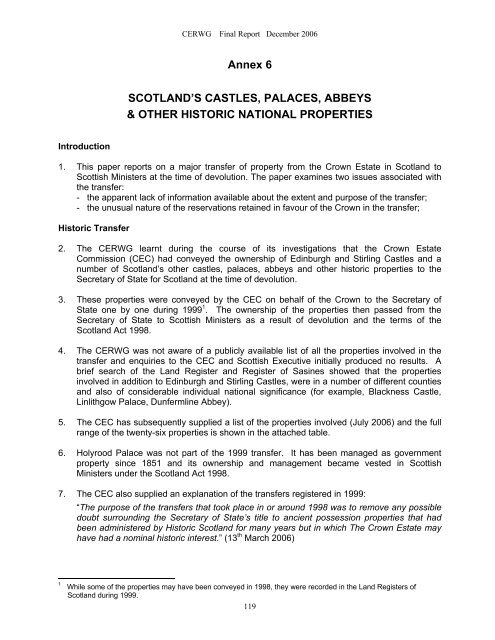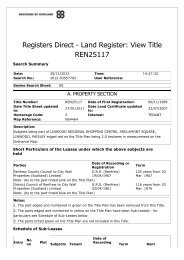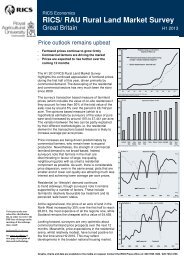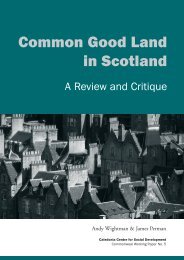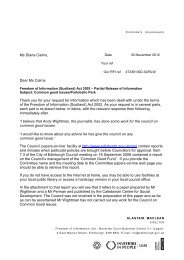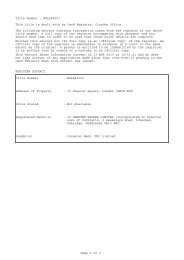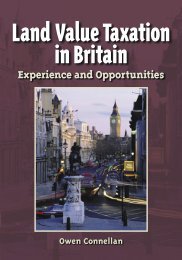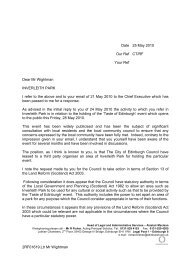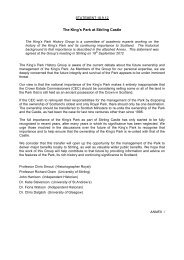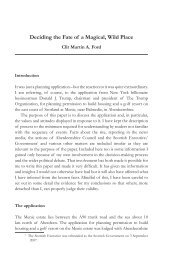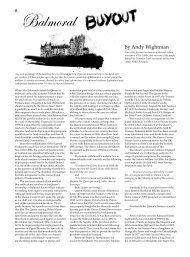Annex 6 SCOTLAND'S CASTLES, PALACES ... - Andy Wightman
Annex 6 SCOTLAND'S CASTLES, PALACES ... - Andy Wightman
Annex 6 SCOTLAND'S CASTLES, PALACES ... - Andy Wightman
Create successful ePaper yourself
Turn your PDF publications into a flip-book with our unique Google optimized e-Paper software.
CERWG Final Report December 2006<strong>Annex</strong> 6SCOTLAND’S <strong>CASTLES</strong>, <strong>PALACES</strong>, ABBEYS& OTHER HISTORIC NATIONAL PROPERTIESIntroduction1. This paper reports on a major transfer of property from the Crown Estate in Scotland toScottish Ministers at the time of devolution. The paper examines two issues associated withthe transfer:- the apparent lack of information available about the extent and purpose of the transfer;- the unusual nature of the reservations retained in favour of the Crown in the transfer;Historic Transfer2. The CERWG learnt during the course of its investigations that the Crown EstateCommission (CEC) had conveyed the ownership of Edinburgh and Stirling Castles and anumber of Scotland’s other castles, palaces, abbeys and other historic properties to theSecretary of State for Scotland at the time of devolution.3. These properties were conveyed by the CEC on behalf of the Crown to the Secretary ofState one by one during 1999 1 . The ownership of the properties then passed from theSecretary of State to Scottish Ministers as a result of devolution and the terms of theScotland Act 1998.4. The CERWG was not aware of a publicly available list of all the properties involved in thetransfer and enquiries to the CEC and Scottish Executive initially produced no results. Abrief search of the Land Register and Register of Sasines showed that the propertiesinvolved in addition to Edinburgh and Stirling Castles, were in a number of different countiesand also of considerable individual national significance (for example, Blackness Castle,Linlithgow Palace, Dunfermline Abbey).5. The CEC has subsequently supplied a list of the properties involved (July 2006) and the fullrange of the twenty-six properties is shown in the attached table.6. Holyrood Palace was not part of the 1999 transfer. It has been managed as governmentproperty since 1851 and its ownership and management became vested in ScottishMinisters under the Scotland Act 1998.7. The CEC also supplied an explanation of the transfers registered in 1999:“The purpose of the transfers that took place in or around 1998 was to remove any possibledoubt surrounding the Secretary of State’s title to ancient possession properties that hadbeen administered by Historic Scotland for many years but in which The Crown Estate mayhave had a nominal historic interest.” (13 th March 2006)1While some of the properties may have been conveyed in 1998, they were recorded in the Land Registers ofScotland during 1999.119
CERWG Final Report December 20068. It appears that the issue of Historic Scotland’s responsibilities and those of the CEC hadcome into sharper focus earlier in the 1990s when Edinburgh and Stirling Castles ceased tobe military garrisons and a body had to take over responsibility from the military authorities 1 .9. This reflects that the issue was not the ownership of the properties. They were ancientpossessions of the Crown in Scotland and Scotland did not gain anything new from the 1999transfers. The transfer was from property held by the Crown in Scotland to property held bythe devolved government in Scotland. The significance was thus more about managementthan ownership.10. The 1999 transfers may have been a “tidying up exercise”, but the transfer to the newScottish administration when the new Scottish Parliament was being established, also had amuch wider national significance for Scotland. However, despite this, there was no mentionof the transfer in the CEC’s Annual Reports. Also, while the transfer was not secret, noother information appears to have been made public about it at the time.Unusual Reservations11. During the 1999 transfers, each conveyancing was entered in either the Land Register orRegister of Sasines depending on its location. The transfer of Edinburgh Castle wasunusual however, as the conveyancing (25 th February 1999) was recorded in the LandRegister for Midlothian two years before the Register became operational (1 st April 2001).The Castle is thus registered as title number MID 1.12. Since the transfers, the CEC has maintained on a number of occasions that:-“The Crown Estate has no continuing property or other interest in Edinburgh Castle, StirlingCastle, Holyrood Palace or any other castles, palaces, abbeys cathedrals, gardens or parks(except where they are part of one of our five rural estates and within our direct and specificownership)” (November 2005) 213. However, the dispositions recorded in the Registers show that the CEC has reserved rightsover the properties conveyed in 1999. The mineral rights are reserved by the CEC over allthe properties and the most prominent properties at least, including Edinburgh and StirlingCastles, are also subject to a second very unusual reservation. The reservations areexpressed in each title in the following terms:-under exception of and reserving to Her Majesty and her Successorsthe whole mines, minerals and fossils insofar as belonging to Her and Them within or underthe subjects hereby disposed andfree right to exercise all rights to which She or They may be presently entitled and allprivileges which She or They may presently enjoy over the subjects hereby disponed;14. Mineral rights are a distinct property right in Scots law and the CEC therefore does, contraryto its statements, have a “continuing interest” in these properties. It is a profound anomalythat the CEC should retain the mineral rights over this iconic group of Scotland’s nationalbuildings.15. The conveyancing is even more of an anomaly when it is not clear that the CEC wasresponsible for any property interest in all or most of the properties in the first place andtherefore entitled to convey them. The conveyancing of these properties by the CEC reflectsa judgement that they all formed part of the Crown Estate. The Crown Estate Act 196112Edinburgh and Stirling Castles briefly featured during the 1990s in CEC reports and public relations activitiesThe CEC does not “own” any of the properties which it manages in Scotland on behalf of the Crown in Scotland120
CERWG Final Report December 2006defines the Crown Estate as lands and other property rights and interests managed by theCEC, yet the CEC acknowledges that the properties “had been administered by HistoricScotland for many years” (para 7 above) 1 .16. Also, none of the properties are identified in the lists of properties making up the CrownEstate in Scotland produced by the CEC over the last 50 years, while there are specificreferences in the CEC’s Annual Reports to the fact that the CEC was not responsible for anumber of the buildings subsequently conveyed in 1999 2 .17. The second reservation in the 1999 transfers after the mineral rights, is very curious anddoes not appear to be legally competent in Scots law. A reservation must be clearlyspecified and any right reserved must be of property or rights which are recognised in Scotslaw.18. The fact that the same wording was used for a number of properties further undermines thenotion that, for example, it was some rights that might form part of the regalia rights whichwere being reserved. Also, the lack of any part of the Crown Estate remaining as anadjoining property to most of the disposed properties, rules out the possibility that servitudesare being reserved. Before 2003, servitudes also had to be clearly specified from arestricted list of possibilities.19. The CEC have recently acknowledged that these reservations exist (July 2006), but to datehave given no indication whether it is the CEC’s intention to convey the mineral rights andsecond reservation to Scottish Ministers.20. When the transfers of all these ancient possessions of Scotland were going through in 1999,the CEC was in the process of concluding a very major ‘landmark’ commercial propertyinvestment in Edinburgh. The CEC decided to name the development “The Prince’sExchange”._________________12It is also not clear how the “free gift” of these properties to the Secretary of State for Scotland fits with therequirement of the Crown Estate Act 1961 3(1) for the CEC to obtain “the best consideration in money or money’sworth which in their opinion can reasonably be obtained” or the limited circumstances to give away property undersection 4 of the Act.for example, CEC Annual Report 1979121
CERWG Final Report December 2006Table 5List of Twenty-Six Historic Properties in Scotlandconveyed by the Crown Estate Commissionerson behalf of the Crownto the Secretary of State for Scotland in 1998/9Edinburgh CastleStirling CastleBlackness CastleDumbarton CastleSt. Andrews CastleBroughty CastleFort CharlotteLinlithgow Palace and LochDunfermline Palace, Chapel and GroundsGlasgow CathedralElgin Cathedral and Burial GroundDunkeld Cathedral and GroundsSt Andrews Cathedral and PrecinctsDunblane CathedralFortrose Cathedral and PrecinctsSt.Machars Cathedral, AberdeenBrechin Cathedral Round TowerArbroath Abbey and PrecinctsDundrennan AbbeyBeauly PriorySt.Mary’s Kirk, St.AndrewsBlackfriars Chapel, St. AndrewsBrechin Maison Dieu ChapelHolyrood ParkKings Knott, StirlingArgyll Lodging Stirling_________Source: List supplied by CEC 6 th July 2006122


